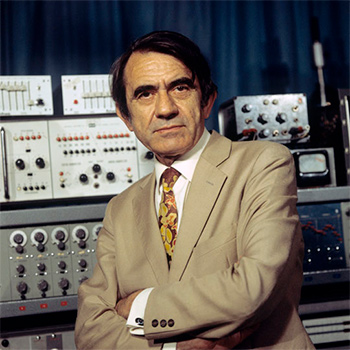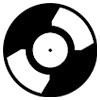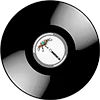
Pierre Schaeffer was born on 18 August 1910 in Nancy, France, into a family of a musician and a librarian. His father introduced him to the world of classical music, while his mother nurtured his love for literature and intellectual discussion. Yet his life was not originally destined for the arts: Schaeffer received an engineering education in electromechanics and radio technology. It was the combination of the technical and the artistic within one person that would soon produce something that changed music forever.
The Beginning: Engineer, Experimenter, Thinker
In the 1930s, Schaeffer began working at French Radio. He engaged in what today would be called sound design—experimenting with recording, editing, microphones, capturing street noises, voices, mechanical sounds, electrical impulses. At the time, such work was regarded as tinkering rather than music.
But Schaeffer gradually developed a radical idea:
music can be created not only with instruments — but also with the sounds of the world around us.
He named this concept objet sonore — the sound object, a basic building block of a future musical composition.
The Birth of Musique Concrète — A Musical Revolution
In 1948, Schaeffer officially announced the creation of a new genre, which he called musique concrète — “concrete music.”
This was not abstract notation, not written scores — but work with real sonic materials recorded on tape:
- footsteps
- city noise
- metal impacts
- trains
- human voices
- reversed recordings
- radio fragments
- mechanical rhythms
- natural sounds
Schaeffer worked like a film director of sound:
cutting tape with scissors, splicing fragments, changing playback speed, reversing audio, layering sounds.
This became the precursor of:
- electronic music
- techno
- IDM
- dub techno
- ambient
- ambient sound design
- sampling in hip-hop
- noise music
- cinematic sound
Key Early Works
Étude aux chemins de fer (1948)
Perhaps his most famous work — “Railway Study.”
A full composition built exclusively from train sounds: wheels, whistles, brakes, rail vibrations.
Today it is considered the first piece of electronic music in history.
Cinq études de bruits — “Five Noise Studies” (1948)
Groundbreaking experiments in rhythm, texture, and noise form.
Symphonie pour un homme seul (1950)
A monumental twelve-part symphony created with Pierre Henry.
Breathing, footsteps, body impacts, coughing, sighs — the most human becomes the music of the future.
GRMC and ORTF: Laboratories of the Future
Schaeffer founded the world’s first dedicated studio for sonic research:
- GRMC — Groupe de Recherche de Musique Concrète
- later GRM — Groupe de Recherches Musicales, still active today
This was more than a studio — it was a scientific and musical institute.
Here emerged innovations such as:
- the tape loop
- the forerunner of the sequencer
- early synthesizers
- filters and resonators
- experimental microphones
- editing techniques that became the basis of sound design
His students included:
- Pierre Henry
- Luciano Berio
- Karlheinz Stockhausen
- Iannis Xenakis
- Bernard Parmegiani
- François Bayle
This school defined the entire landscape of European electronic music in the second half of the 20th century.
The Theory of Sound — Schaeffer as Philosopher
Pierre Schaeffer didn’t simply compose; he developed the first systematic philosophy of sound, comparable to Kandinsky’s impact on visual art.
Écoute réduite — reduced listening
Listening to the sound itself, without identifying its source.
Experiencing structure rather than meaning.
Objet sonore — sound object
The minimal unit of sound composition.
Typo-morphologie
A classification of all possible sounds — a sonic equivalent to Mendeleev’s periodic table.
These ideas are fundamental today in:
- cinema
- digital audio design
- modular synthesis
- ambient
- experimental music
- media art
Rare and Little-Known Facts
- Schaeffer disliked the word “composer” and referred to himself as a sound researcher, seeing himself closer to engineers than to musicians.
- He aspired to be a writer and left several novels and philosophical works.
- Despite pioneering technology, Schaeffer did not appreciate electronic dance music, calling it “mechanically beautiful but lacking meaning.”
- He conducted early studies on the psychology of listening, decades before neuroacoustics appeared.
- He created early experiments in generative (algorithmic) music using tape loops as primitive infinite structures.
- He recorded animals, machinery, rain, and wind long before field recording became an art form.
- Late in life, he feared that “technology will overtake music entirely” — a prophetic statement in today’s era of digital audio workstations.
Complete Discography of Pierre Schaeffer
The following is the most comprehensive list of his major works, including compositions, cycles, albums, collaborations, and archival releases.
Major Works (Chronological)
1948
- Étude aux chemins de fer
- Étude aux tourniquets
- Étude au piano I
- Étude au piano II
- Étude violette
- Étude noire
- Cinq études de bruits (cycle)
1950
- Symphonie pour un homme seul (with Pierre Henry)
1951–1953
- Variations sur une flûte mexicaine
- Étude aux allures
1958–1959
- Concert de bruits
- La coquille à planètes (radio opera)
1960
- Étude aux objets
1961–1967
- Le trièdre fertile
- Scènes de la vie future
- Prosopopée
1970s
- GRM cycles
- archival radio experiments
- material for Solfege de l’objet sonore
Collaborative Works
With Pierre Henry
- Symphonie pour un homme seul
- Orphée 51
- Messe pour le temps présent (conceptual contribution)
With Iannis Xenakis and François Bayle
- numerous GRM recordings
- joint experiments for ORTF
Late and Archival Releases
- Pierre Schaeffer – L’Œuvre Musicale (complete anthology)
- Archives GRM – Volume I–III
- Solfege de l'objet sonore (educational audio series)
- Le Trièdre Fertile – Complete Works
Pierre Schaeffer as a Founder of 21st-Century Sound Culture
Modern music would be unimaginable without Schaeffer’s ideas:
- ambient
- techno
- experimental
- IDM
- glitch
- film sound design
- audio art
- field recording
- sample-based music
- modular synthesis
All of these are rooted in his principles:
sound as art, sound as an object, sound as form.
Pierre Schaeffer permanently changed the world's understanding of what music can be. He was the first to step into places where nobody searched for art: noise, mechanical vibration, the sounds of nature and the city. His work became the foundation of the entire electronic and experimental scene—from ambient to techno, from sound design to academic avant-garde.
Most importantly, Schaeffer gave the world a new way to listen: attentively, consciously, beyond familiar boundaries. His legacy lives on in every studio where a musician experiments with an unusual sound; in every composition where noise becomes music; in every listener who hears not only notes but the space between them.
Pierre Schaeffer remains not just a pioneer — but a voice of the future that continues to resonate today.

